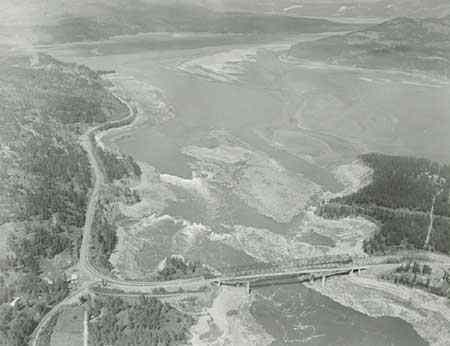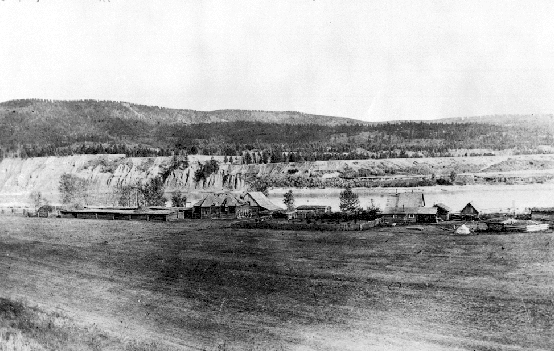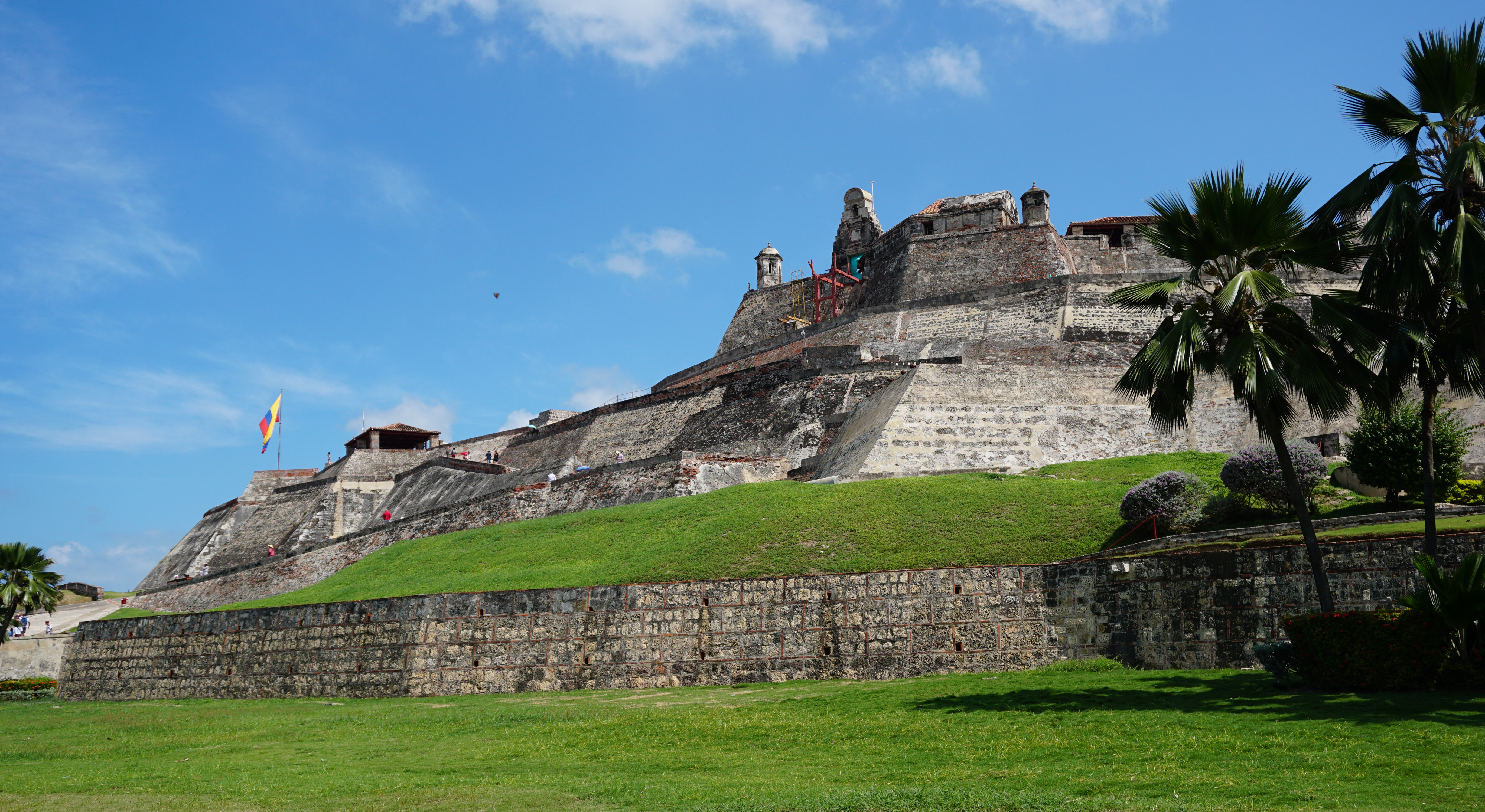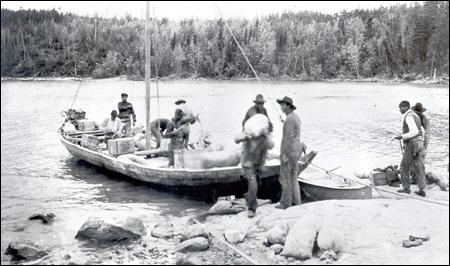|
Columbia Boat
The Columbia boat was a type of inland boat, similar to the York Boat, used to carry furs, trade goods, supplies, and passengers along the Columbia River during the fur trade era, c. 1811–1845. It needed to be large enough to carry substantial cargo, light enough to portage around such obstacles as falls and rapids, and made of locally sourced materials. It was modeled after the birchbark canoe used in waterways east of the Rocky Mountains, but was sheathed with thin cedar planks. History and construction North West Company explorer David Thompson built the first prototype of the Columbia boat in 1811, when he crossed the Rocky Mountains via Athabasca pass. At the spot on the Columbia River known thereafter as Boat Encampment, Thompson searched for birchbark to make a canoe. What little he found was too thin, so he sheathed the canoe with planks split from cedar. In 1824 Hudson's Bay Company Chief Factor Alexander Kennedy, John McLoughlin's predecessor as superintendent of HBC ... [...More Info...] [...Related Items...] OR: [Wikipedia] [Google] [Baidu] |
York Boat
The York boat was a type of inland boat used by the Hudson's Bay Company to carry furs and trade goods along inland waterways in Rupert's Land, the watershed stretching from Hudson Bay to the eastern slopes of the Rocky Mountains. It was named after York Factory, the headquarters of the HBC, and modeled after the Orkney yole (itself a descendant of the Viking longship). Two variations to the York Boat were scows and "Sturgeon Heads." History and economics York boats were preferred as cargo carriers to the birchbark canoes used by the North West Company, because they were larger, carried more cargo and were safer in rough water. The boat's heavy wood construction was a significant advantage when travelling waterways where the bottom or sides of the hull were likely to strike rocks or ice. Canoes then were commonly constructed with soft hulls of birch bark or animal hide and were vulnerable to tears and punctures. The solid, all-wood hull of the York boat could simply bounce off or ... [...More Info...] [...Related Items...] OR: [Wikipedia] [Google] [Baidu] |
Kettle Falls
Kettle Falls ( Salish: Shonitkwu, meaning "roaring or noisy waters", also Schwenetekoo translated as "Keep Sounding Water") was an ancient and important salmon fishing site on the upper reaches of the Columbia River, in what is today the U.S. state of Washington, near the Canada–US border. The falls consisted of a series of rapids and cascades where the river passed through quartzite rocks deposited by prehistoric floods on a substrate of Columbia River basalt. The river dropped nearly , and the sound of the falls could be heard for miles away. Kettle Falls was inundated in 1940, as the waters of the reservoir Lake Roosevelt rose behind Grand Coulee Dam, permanently flooding the site. History At least nine thousand years ago Paleo-Indian cultures gathered at Kettle Falls to fish and gather foods. Salish-speaking people arrived about two thousand years ago, and gradually the falls became the center of an extensive network of Native American trade based on a salmon e ... [...More Info...] [...Related Items...] OR: [Wikipedia] [Google] [Baidu] |
Fort Alexandria
Alexandria or Fort Alexandria is a National Historic Site of Canada on the Fraser River in British Columbia, and was the end of the Old Cariboo Road and the Cariboo Wagon Road. It is located on Highway 97, north of 100 Mile House and south of Quesnel. History On June 21, 1793, explorer Alexander MacKenzie reached the shores of the First Nations village at what would become Alexandria. He was told by the people of the village that the river was not safe for navigation beyond that point. Mackenzie heeded their advice and he and his party turned around and returned upriver to what would become the town of Quesnellemouth, (later Quesnel) and continued on to Bella Coola. In 1821, the North West Company erected a fort at Alexandria, the last the company would build before it was merged the same year with the Hudson's Bay Company. The fort was named Alexandria in honour of Alexander Mackenzie. They also built a granary and wintered their horses there. Alexandria became a key way st ... [...More Info...] [...Related Items...] OR: [Wikipedia] [Google] [Baidu] |
Fraser River
The Fraser River is the longest river within British Columbia, Canada, rising at Fraser Pass near Blackrock Mountain in the Rocky Mountains and flowing for , into the Strait of Georgia just south of the City of Vancouver. The river's annual discharge at its mouth is or , and it discharges 20 million tons of sediment into the ocean. Naming The river is named after Simon Fraser, who led an expedition in 1808 on behalf of the North West Company from the site of present-day Prince George almost to the mouth of the river. The river's name in the Halqemeylem (Upriver Halkomelem) language is , often seen archaically as Staulo, and has been adopted by the Halkomelem-speaking peoples of the Lower Mainland as their collective name, . The river's name in the Dakelh language is . The ''Tsilhqot'in'' name for the river, not dissimilar to the ''Dakelh'' name, is , meaning Sturgeon ''()'' River ''()''. Course The Fraser drains a area. Its source is a dripping spring at Fras ... [...More Info...] [...Related Items...] OR: [Wikipedia] [Google] [Baidu] |
Fort St
A fortification is a military construction or building designed for the defense of territories in warfare, and is also used to establish rule in a region during peacetime. The term is derived from Latin ''fortis'' ("strong") and ''facere'' ("to make"). From very early history to modern times, defensive walls have often been necessary for cities to survive in an ever-changing world of invasion and conquest. Some settlements in the Indus Valley civilization were the first small cities to be fortified. In ancient Greece, large stone walls had been built in Mycenaean Greece, such as the ancient site of Mycenae (famous for the huge stone blocks of its ' cyclopean' walls). A Greek '' phrourion'' was a fortified collection of buildings used as a military garrison, and is the equivalent of the Roman castellum or English fortress. These constructions mainly served the purpose of a watch tower, to guard certain roads, passes, and borders. Though smaller than a real fortress, the ... [...More Info...] [...Related Items...] OR: [Wikipedia] [Google] [Baidu] |
British Columbia
British Columbia (commonly abbreviated as BC) is the westernmost Provinces and territories of Canada, province of Canada, situated between the Pacific Ocean and the Rocky Mountains. It has a diverse geography, with rugged landscapes that include rocky coastlines, sandy beaches, forests, lakes, mountains, inland deserts and grassy plains, and borders the province of Alberta to the east and the Yukon and Northwest Territories to the north. With an estimated population of 5.3million as of 2022, it is Canada's Population of Canada by province and territory, third-most populous province. The capital of British Columbia is Victoria, British Columbia, Victoria and its largest city is Vancouver. Vancouver is List of census metropolitan areas and agglomerations in Canada, the third-largest metropolitan area in Canada; the 2021 Canadian census, 2021 census recorded 2.6million people in Metro Vancouver Regional District, Metro Vancouver. The First Nations in Canada, first known human inhabi ... [...More Info...] [...Related Items...] OR: [Wikipedia] [Google] [Baidu] |
York Boat
The York boat was a type of inland boat used by the Hudson's Bay Company to carry furs and trade goods along inland waterways in Rupert's Land, the watershed stretching from Hudson Bay to the eastern slopes of the Rocky Mountains. It was named after York Factory, the headquarters of the HBC, and modeled after the Orkney yole (itself a descendant of the Viking longship). Two variations to the York Boat were scows and "Sturgeon Heads." History and economics York boats were preferred as cargo carriers to the birchbark canoes used by the North West Company, because they were larger, carried more cargo and were safer in rough water. The boat's heavy wood construction was a significant advantage when travelling waterways where the bottom or sides of the hull were likely to strike rocks or ice. Canoes then were commonly constructed with soft hulls of birch bark or animal hide and were vulnerable to tears and punctures. The solid, all-wood hull of the York boat could simply bounce off or ... [...More Info...] [...Related Items...] OR: [Wikipedia] [Google] [Baidu] |
Hudson Bay
Hudson Bay ( crj, text=ᐐᓂᐯᒄ, translit=Wînipekw; crl, text=ᐐᓂᐹᒄ, translit=Wînipâkw; iu, text=ᑲᖏᖅᓱᐊᓗᒃ ᐃᓗᐊ, translit=Kangiqsualuk ilua or iu, text=ᑕᓯᐅᔭᕐᔪᐊᖅ, translit=Tasiujarjuaq; french: baie d'Hudson), sometimes called Hudson's Bay (usually historically), is a large body of saltwater in northeastern Canada with a surface area of . It is located north of Ontario, west of Quebec, northeast of Manitoba and southeast of Nunavut, but politically entirely part of Nunavut. Although not geographically apparent, it is for climatic reasons considered to be a marginal sea of the Arctic Ocean. It drains a very large area, about , that includes parts of southeastern Nunavut, Alberta, Saskatchewan, Ontario, Quebec, all of Manitoba, and parts of the U.S. states of North Dakota, South Dakota, Minnesota, and Montana. Hudson Bay's southern arm is called James Bay. The Eastern Cree name for Hudson and James Bay is (Southern dialect) or ( ... [...More Info...] [...Related Items...] OR: [Wikipedia] [Google] [Baidu] |
Fort Vancouver
Fort Vancouver was a 19th century fur trading post that was the headquarters of the Hudson's Bay Company's Columbia Department, located in the Pacific Northwest. Named for Captain George Vancouver, the fort was located on the northern bank of the Columbia River in present-day Vancouver, Washington. The fort was a major center of the regional fur trading. Every year trade goods and supplies from London arrived either via ships sailing to the Pacific Ocean or overland from Hudson Bay via the York Factory Express. Supplies and trade goods were exchanged with a plethora of Indigenous cultures for fur pelts. Furs from Fort Vancouver were often shipped to the Chinese port of Guangzhou where they were traded for Chinese manufactured goods for sale in the United Kingdom. At its pinnacle, Fort Vancouver watched over 34 outposts, 24 ports, six ships, and 600 employees. Today, a full-scale replica of the fort, with internal buildings, has been constructed and is open to the public as For ... [...More Info...] [...Related Items...] OR: [Wikipedia] [Google] [Baidu] |
York Factory Express
The York Factory Express, usually called "the Express" and also the Columbia Express and the Communication, was a 19th-century fur brigade operated by the Hudson's Bay Company (HBC). Roughly in length, it was the main overland connection between HBC headquarters at York Factory, Manitoba, York Factory and the principal depot of the Columbia District, Columbia Department, Fort Vancouver. It was named "express" because it was not used to transport furs and supplies, but to quickly move departmental requisitions, reports, and correspondence, as well as personnel—new hires inland, retirees outbound, and Company officers being transferred or going on furlough. The express brigade was known as the York Factory Express on its eastbound journey in the spring, and as the Columbia Express or Autumn Express on its westbound journey in the fall back on the same route. Supplies and trade goods for the Columbia District were brought from Britain to Fort Vancouver every year by ship around S ... [...More Info...] [...Related Items...] OR: [Wikipedia] [Google] [Baidu] |
Carvel (boat Building)
Carvel built or carvel planking is a method of boat building in which hull planks are laid edge to edge and fastened to a robust frame, thereby forming a smooth surface. Traditionally the planks are neither attached to, nor slotted into, each other, having only a caulking sealant between the planks to keep water out. Modern carvel builders may attach the planks to each other with glues and fixings. It is a "frame first" method of hull construction, where the shape is determined by the framework onto which the planks are fixed. This is in contrast to "plank first" or "shell first" methods, where the outer skin of the hull is made and then reinforced by the insertion of timbers that are fitted to that shape. The most common modern "plank first" method is clinker construction; in the classical period "plank first" involved joining the edges of planks with mortise and tenon joints within the thickness of the timbers, superficially giving the smooth-hull appearance of carvel constr ... [...More Info...] [...Related Items...] OR: [Wikipedia] [Google] [Baidu] |
Yole
A yole is a clinker built boat that was used for fishing particularly in the north of Scotland. The best known of these is the Orkney Yole. They were rigged for sail or used as rowing boats. The yole is a Nordic design and closely related in shape to the Shetland Yoal and Sgoth Niseach of the Outer Hebrides. See also * Orkney Heritage Society The Orkney Heritage Society in Orkney, Scotland, is a nonprofit organisation founded in 1968. It promotes "the beauty, history and character of Orkney" as well as "high standards of architecture and planning" in Orkney. It organizes conferences and ... External linksOrkney Yole Association website Sailboat types Types of fishing vessels Orcadian culture Scottish design Fishing in Scotland Rowing boats {{ship-type-stub ... [...More Info...] [...Related Items...] OR: [Wikipedia] [Google] [Baidu] |








